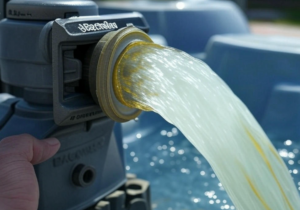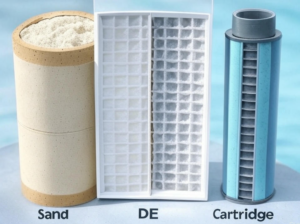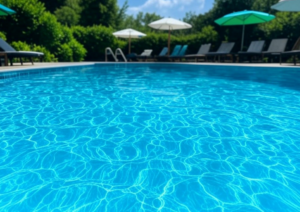Do I Need to Backwash After Vacuuming? The Ultimate Pool Filter Maintenance Guide
Maintaining a sparkling pool is easier when you understand each step of the process. One common question among pool owners is, “Do I need to backwash after vacuuming?” In this guide, you will learn what backwashing is, why it matters, and when you should do it. We will also explore related topics, including solar blankets for hot tubs, so you get a full picture of pool and hot tub care. By the end of this guide, you will have clear steps and practical tips for keeping your filter running efficiently, saving water and money.
In simple words, backwashing is the process of cleaning your pool filter by reversing the water flow. Vacuuming the pool sends debris into your filter. If too much dirt collects, the filter pressure increases, and water flow slows down. This can lead to cloudy water and even damage your pump. For most sand and diatomaceous earth (DE) filters, experts recommend backwashing if the pressure gauge goes up by 8–10 PSI above normal. Cartridge filters work differently; they need to be removed and washed, not backwashed.
Why does this matter to you? A clean filter means clear water and a healthy pool. You also save on chemicals and reduce wear on your equipment. In addition, some pool owners use solar blankets on their hot tubs. These blankets capture the sun’s heat, reduce evaporation, and help maintain water temperature. Both practices—backwashing and using a solar blanket—contribute to a more energy-efficient and enjoyable pool experience.
This guide will explain:
- What backwashing is and why it matters.
- How different filter types affect the backwashing process.
- When you should and should not backwash.
- Step-by-step instructions for backwashing and filter care.
- A look at solar blankets and how they help save energy.
- A troubleshooting section to solve common issues.
- Expert answers to frequently asked questions.
Let’s explore all these ideas in detail so you can make informed decisions about your pool maintenance routine.

Main Topic Exploration
Understanding Backwashing and Vacuuming
Backwashing is the process of reversing water flow through your pool filter. When you vacuum your pool, debris such as leaves, dirt, and algae is pulled into the filter. Over time, this debris clogs the filter media, increasing the pressure inside the system. An 8–10 PSI rise in pressure above your clean filter level usually signals that backwashing is needed. For cartridge filters, you do not backwash. Instead, you must remove the cartridge and clean it manually.
Backwashing helps:
- Remove trapped debris from sand and DE filters.
- Restore water flow and maintain pressure levels.
- Prevent damage to the pump and filter system.
When you vacuum on “filter” mode, the debris goes directly to your filter. If you vacuum on “waste” mode, the debris bypasses the filter. In the latter case, backwashing may not be needed unless the filter was already dirty.
The Role of Filter Type
Your pool filter type is key to understanding backwashing:
- Sand Filters:
These traps debris in a sand bed. If you vacuum heavily or notice a pressure rise, backwash is recommended. - DE (Diatomaceous Earth) Filters:
These are very effective at catching fine particles. They clog faster and must be backwashed—and recharged with new DE powder—when pressure increases. - Cartridge Filters:
These filters do not require backwashing. Instead, you remove and rinse the cartridge with a hose or soak it in a cleaning solution.

Solar Blankets for Hot Tubs
Solar blankets work on similar energy-saving principles as proper filter maintenance. They are lightweight covers that float on the water surface to:
- Capture solar heat: The blanket lets sunlight warm the water.
- Reduce evaporation: By keeping water from evaporating, the blanket helps retain heat.
- Save energy: With less heat lost, the heater works less hard, lowering energy bills.
Using a solar blanket is a smart way to reduce energy consumption. It is a low-cost addition to your hot tub care routine, much like backwashing is an essential part of pool care.
Comparative Analysis
Below is a table that compares the three main filter types and their maintenance needs after vacuuming:
Here is another table comparing vacuuming modes:
Diagram: Pool Filter Maintenance Process
Below is a simple HTML diagram that shows the basic process from vacuuming to backwashing:
Performance Factors
A few key factors affect when you should backwash after vacuuming:
-
Filter Pressure:
The best guide is your filter’s pressure gauge. If the pressure rises by 8–10 PSI above the clean baseline, it is time to backwash. -
Debris Load:
Heavy vacuuming of leaves, algae, or sediment calls for immediate backwashing. Light vacuuming may not require it. -
Filter Type:
Sand and DE filters need backwashing, while cartridge filters need manual cleaning. -
Water Clarity:
Cloudy water after vacuuming indicates the filter may be overloaded. -
Vacuuming Mode:
Vacuuming in “waste” mode sends debris away from the filter, reducing the need for backwashing.
Actionable Tips:
- Always record your normal clean filter pressure.
- Check the gauge before and after vacuuming.
- Adjust your maintenance schedule based on your pool’s usage and debris load.
A clear understanding of these factors helps you avoid unnecessary backwashing. This saves water and extends the life of your filter media.
Implementation Guide
Follow these step-by-step instructions to maintain your pool filter effectively:
-
Pre-Vacuuming:
- Check the pressure gauge. Record your clean filter pressure.
- Brush the pool floor to loosen stuck debris.
-
Vacuuming:
- Set your vacuum to the appropriate mode.
- Filter Mode: For regular cleaning.
- Waste Mode: For heavy debris.
- Slowly vacuum the pool to avoid stirring up too much dirt.
- Set your vacuum to the appropriate mode.
-
Post-Vacuuming Check:
- Observe the pressure gauge immediately after vacuuming.
- If the pressure rises by 8–10 PSI, prepare for backwashing.
-
Backwashing Process (For Sand and DE Filters):
- Turn off the pump.
- Set the multiport valve to “Backwash.”
- Restart the pump and run it for 2–3 minutes until the water in the sight glass is clear.
- Turn off the pump again and switch to “Rinse” for 30–60 seconds.
- Return the valve to “Filter” and restart the pump.
- For DE filters, add fresh DE powder after backwashing.
-
For Cartridge Filters:
- Remove the cartridge.
- Use a hose to clean off the trapped debris.
- Soak the cartridge in a cleaning solution if needed.
- Replace the cartridge and reassemble the filter.
-
Final Check:
- Confirm the pressure gauge is back to the normal range.
- Ensure water clarity is restored.
Expert Tip:
Regularly monitor your pool’s water clarity and pressure gauge. This helps you decide if you need to backwash sooner or if you can delay it.
“A well-maintained filter not only keeps your pool water clear but also extends the life of your entire pool system.”
– Pool Maintenance Expert
Troubleshooting Section
Sometimes, even with careful care, issues may arise. Here are common problems and how to solve them:
-
Cloudy Water After Vacuuming:
- Diagnosis: The filter may be clogged.
- Solution: Backwash the filter if using sand or DE. For cartridge filters, remove and rinse the cartridge.
-
No Pressure Change on Gauge:
- Diagnosis: You may have vacuumed lightly or the gauge is faulty.
- Solution: Clean the filter manually and double-check the gauge reading.
-
Debris Returning to the Pool:
- Diagnosis: A damaged filter cartridge or worn-out filter media.
- Solution: Inspect for rips or damage. Replace the cartridge or filter media if needed.
-
Reduced Water Flow:
- Diagnosis: Clogged filter or pump issues.
- Solution: Backwash the filter if needed. If the problem persists, check the pump basket for blockages.
-
Temporary Cloudiness After Backwashing:
- Diagnosis: Residual dirty water in the system.
- Solution: Run the pump on “Filter” mode for a short period. A brief rinse cycle may also help.
“Regular checks and prompt action on small issues can prevent big problems down the line.”
– Certified Pool Technician
By following this simple decision process and acting quickly on these signals, you can avoid long-term damage and maintain crystal clear water.

Innovation and Extended Applications
Modern pool maintenance is evolving. Here are a few trends and creative uses that complement traditional backwashing:
-
Automation:
New systems allow automatic monitoring of filter pressure and can even schedule backwashing when needed. This saves time and prevents human error. -
Remote Monitoring:
Some advanced filters let you monitor water quality and pressure through smartphone apps. This innovation makes it easier to know when your filter needs attention. -
Solar Blankets on Hot Tubs:
As mentioned earlier, solar blankets can be a smart add-on. They capture sunlight to warm the water and reduce evaporation. This can lead to lower energy costs and a more eco-friendly hot tub experience. -
Energy Efficiency:
Both proper backwashing and solar blankets help reduce energy consumption. They minimize the workload on your heater and pump, extending the life of your pool equipment. -
Future Trends:
Expect to see more smart devices that integrate with home automation systems. These tools can alert you to maintenance needs and even recommend the best cleaning times based on weather patterns.
These innovations make pool maintenance easier and more effective. They are also a great way to save money and protect the environment over the long term.
Long-term Considerations
When planning for long-term pool care, consider the following:
-
Sustainability:
Avoid unnecessary backwashing to save water and reduce chemical waste. Use only when needed based on pressure readings. -
Maintenance Requirements:
Regular checks of your pressure gauge and filter condition are key. An optimal maintenance schedule can extend the life of your filter and pump. -
Cost-Benefit Analysis:
Over time, careful maintenance can save money by reducing water, chemical usage, and energy costs. Replace worn parts promptly to avoid more expensive repairs later. -
Upgrades:
Consider upgrading to smart filters or energy-efficient pumps. These investments may have a higher initial cost but pay off in long-term savings.
A thoughtful maintenance plan keeps your pool in top shape for years to come.
Expert FAQ Section
Q1: How do I know if my filter pressure is too high?
A: Check your pressure gauge. A reading 8–10 PSI above your clean filter pressure means it is time to backwash or clean the cartridge.
Q2: Can I skip backwashing if my pool looks clean?
A: Even if the pool water looks clear, debris in the filter can build up. It is best to check the pressure gauge to decide.
Q3: What happens if I backwash too often?
A: Over-backwashing wastes water and chemicals. It can also wear down the filter media faster, reducing the lifespan of your filter.
Q4: Do I need to backwash if I vacuum in “waste” mode?
A: No, since “waste” mode bypasses the filter. However, check your filter before vacuuming to see if it is already dirty.
Q5: How often should I clean my cartridge filter?
A: Clean your cartridge filter every 4–6 weeks or as soon as you notice a drop in water flow. Replace it every 1–2 years based on use.
Q6: What is the cost impact of regular backwashing?
A: Regular backwashing, when done only as needed, can save money by keeping your system efficient and reducing extra chemical use.
Q7: Are there any risks if I ignore high pressure readings?
A: Yes, ignoring high pressure can lead to reduced water flow, cloudy water, and strain on your pump, possibly leading to expensive repairs.
Conclusion
In summary, whether you need to backwash after vacuuming depends on your pool filter type, the amount of debris, and the pressure gauge reading. For sand and DE filters, an 8–10 PSI increase above the clean pressure is a clear sign that backwashing is needed. Cartridge filters require manual cleaning instead. By monitoring your filter’s performance and using the right vacuum mode, you can keep your pool water crystal clear while saving water and energy.
Remember the benefits: a clean filter leads to better water quality, extended equipment life, and lower maintenance costs. Use the expert tips provided in this guide to develop a routine that works for you. If you enjoy saving energy, consider pairing your pool care routine with a solar blanket for your hot tub. It’s an extra step that brings both comfort and cost savings.
Now is the time to review your current pool care routine and adjust it with these insights. Your pool and hot tub will thank you!
Additional Resources
- Pool & Spa News – Articles on maintenance and product reviews.
- The Pool Guy – Practical advice for home pool care.
- Energy Star Guidelines for Pools – Tips on energy efficiency.
- DIY Pool Maintenance Forums – Community advice and troubleshooting.
- Consumer Reports – Pool Equipment – In-depth reviews and recommendations.
Technical Glossary
Below is a glossary of uncommon or technical terms used in this guide:
- Backwashing: Reversing water flow through the filter to clean out debris.
- DE Filter: A filter using diatomaceous earth powder to trap fine particles.
- Multiport Valve: A valve that controls the various functions of a pool filter.
- Pressure Gauge: A device that measures the pressure inside the pool filter.
- Recirculate: Running water through the filter and back to the pool without backwashing.
- Waste Mode: A vacuum setting that sends debris out of the pool without filtering.
- Solar Blanket: A cover that floats on water to capture heat and reduce evaporation.
- Silt: Fine soil particles that can settle at the pool bottom.
- Turbidity: The cloudiness of water due to suspended particles.
- Cartridge Filter: A filter that uses replaceable cartridges to trap debris.
Key Takeaways
Backwashing after vacuuming is essential for sand and DE filters when the pressure gauge rises 8–10 PSI above normal.
Cartridge filters require manual cleaning instead.
Monitor your filter’s performance and choose the right vacuum mode to save water and chemicals.
Solar blankets can further boost energy savings for your hot tub by retaining heat and reducing evaporation.
By following these steps and tips, you can enjoy a clean, efficient pool all season long. Ready to upgrade your routine? Try out the Pool Maintenance Calculator today!
Feel free to share your thoughts or ask for further details on any section. Happy pool keeping!
